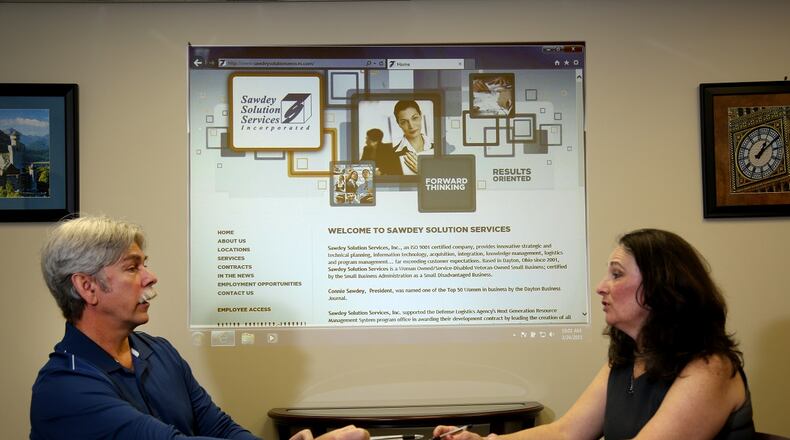Sawdey opened her business after working for another company where she always wanted to be a local leader, she said. When her boss retired, she applied for the job.
“They brought somebody else in instead,” she said. “And I was having to train my boss on how to do his job.”
Eventually Sawdey’s husband, who became the second employee of Sawdey’s Solutions Services after 18 months, encouraged her to open her own business.
“The most important thing for a women-owned business owner is a good support structure,” she said. “Generally speaking it’s hard to find a peer.”
Only 1.7 percent of all women-owned businesses generate more than $1 million annually, but the number of high-earning, women firms has increased 46 percent in the last 11 years, compared to 12 percent of all U.S. businesses, according to a recent report from American Express.
“That’s a very healthy sign,” said American Express’s research advisor Geri Stengel. “There’s a lot of support now, not just of women starting business and maybe starting them out of necessity, but there’s also a lot of support for women that are growing high-growth companies.”
Those high-earning firms account for 68 percent of employment and 69 percent of revenue among all women-owned businesses.
»RELATED: 2 area Elder-Beerman’s close, 3 more to shutter Wednesday
To help women business owners find those peers, Inna Kinney founded the Economic and Community Development Institute in Columbus in 2004 after seeing a gap in entrepreneurial services for minorities, including women. The organization offers one-on-one mentorships to help women business owners who don’t have the same networks as men.
»RELATED: Giant empty retail space clouds Dayton Mall’s future
Capital is another concern for women-business owners who don’t always have the same assets, incomes or collateral as men, Kinney said.
“You can have the best idea in the world, and you can be a great operator, but if you don’t have capital available, you can’t move forward,” she said. “And we know that financial institutions oftentimes do not give money to women businesses.”
Amelia Rodriguez, founder of Vocalink Language Services, has taken advantage of all the resources offered by groups like Kinneys. Rodriguez started her business in 1995 when she saw a gap in translation services that she could help fill. While the industry was in full scale, the Midwest wasn’t as sophisticated yet, she said.
Rodriguez started offering help to financial, license, medical and legal institutions. She said as she grew her business that brought in $4.68 million in 2017 and has about 400 part-time employees and roughly 28 administrators, she used all the tools possible, including from the Women’s Business Enterprise National Council.
»RELATED: Walmart adds news online outdoor merchandise store
“Womens Business Enterprise has regular meetings… and they have specialists come in and they coach you on how to run your marketing, how to run finance, how to create social media. So there’s a lot more help today, I think, than there was before,” Rodriguez said. “There is nothing you cannot do now because the resources are so rich.”
Women have made strides over the past several decades that have helped them start businesses and become high earners, and those strides will continue, Kinney said.
As the number of high-earning, women-owned companies continues to grow, so does the number of all women-owned businesses regardless of revenue, but the latter’s growth is slowing. With women now owning 40 percent of businesses, it makes sense that growth would slow, Stengel said.
As the economy recovers from the recession, women-owned business growth by firm number will slow more, Stengel said, even though the revenues and employment of the businesses are likely to continue growing.
»RELATED: UD police taking attack on professor to prosecutor’s panel for approval of charges
During the recession, women started businesses out of necessity, Stengel said. Entrepreneurship may not have been the first option for those business owners, but when jobs were hard to find — and quality jobs were even more rare — they were left with little choice.
The number of women-owned firms has increased 3,000 percent to almost 12.3 million since 1972, almost 58 percent since 2007 and 5.7 percent since last year, according to the report. On the other hand, Ohio, which is ranked at number 22 for fastest growth of women-owned firms, grew at a much slower rate. There are about 37 percent more women-owned businesses in the Buckeye state now than in 2007, but within the last year, Ohio actually lost 200 businesses owned by women.
But that slow down isn’t necessarily a bad thing, Stengel said. It means Ohio, which was hit harder by the recession is recovering. And as the economy improves, especially in the last year with unemployment hitting record lows and wages on the rise, women return to the workforce in their desired fields.
“I’m excited today about the opportunities that are available for women to go into business for themselves,” Sawdey said. “I don’t think that my mother would have had these same opportunities and I think that our daughter has similar opportunities or will have greater opportunities.”
FIVE FAST READS
• Plan to see new products at local ALDI stores: Here’s what we know
• Sears among six retailers closing in Ohio this year
• Local Elder-Beerman stores could close as early as Sunday
•Temperature abuse caused Chipotle outbreak: 3 things to know about it
About the Author
